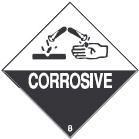Everyday Hazmat User's Training Guide
Section III Hazardous Materials Management (continued)
Corrosives (continued)
Permitting
Having more than a minimum quantity of corrosives on USDA Forest Service property may require a permit from your local fire marshal.
Permits May Be Required
If you have a total of more than 500 pounds of solid corrosives or more than 55 gallons of liquid corrosives onsite, in storage, or in use at any one time, regardless of the number of different products, you may need a permit; check with your local fire marshal for more information.
The local fire marshal may not elect to require permits based on quantities of hazardous materials stored; be sure to check with your local fire marshal for specific permitting requirements.
Transportation
Regulations restrict the transportation of corrosive products, even on USDA Forest Service property. Check with your local fire marshal and State Department of Transportation (DOT) to see if they may have more restrictive requirements. If you plan to move corrosives by air, refer to the USDA Forest Service Interagency Aviation Transport of Hazardous Materials.
USDA Forest Service-Operated Pickups and Trucks
- You can avoid placarding and shipping papers by transporting
battery acid, muriatic acid, hydrochloric acid, or any combination of these
acids in containers that do not weigh more than 66 pounds (including packaging)
or
hold more than 8 gallons. The total weight of all containers may not exceed
440 pounds. See your hazmat coordinator for details or if you are transporting
other
acids.
- When batteries are being transported, they should not be carried with
other hazardous materials unless they are packaged to prevent them from
mixing with or being damaged by these materials. Batteries should be stored
in a way
that prevents
short circuits when they are being transported.
- Regardless of how much hazardous
materials are being shipped, the driver must be informed of the product
types and quantities.
- Remember, to avoid the complexities of shipping papers, placarding, and emergency response training, keep the total weight of all hazardous materials below 440 pounds.
Other Requirements
- No smoking during loading and unloading.
- Keep fire
away from the vehicle.
- Prevent the vehicle from moving (set
brakes).
- Use tools that will not damage packaging.
- Brace packages to prevent
movement.
- Do not ship incompatible materials with corrosives.
- Do not ship
nitric acid with other corrosives.
- Have shipping papers in order.
- If the
load exceeds 119 gallons or is 1,001 pounds or more, the driver must have
a commercial driverís license, hazmat endorsement, medical certificate, and the training required
by the DOT.
- Make sure each container is marked with the proper shipping name
of the product (as defined by the DOT), identification number for the specific
product, and the sender or
receiverís name and address. The technical
name of the product also may be required.
- All products must have the label for corrosives.

Vehicle Placard
![]()
Identification Number
(Be sure to select the
proper number based on
the specific
product.)
